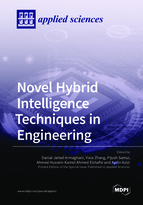Novel Hybrid Intelligence Techniques in Engineering
A special issue of Applied Sciences (ISSN 2076-3417). This special issue belongs to the section "Computing and Artificial Intelligence".
Deadline for manuscript submissions: closed (31 December 2022) | Viewed by 49477
Special Issue Editors
Interests: rock mechanics; tunneling; artificial intelligence and optimization algorithms; geotechnical engineering
Special Issues, Collections and Topics in MDPI journals
Interests: composite materials; composite structures; fibre-reinforced cementitious composites; sustainable construction material; green cement; 3D printing
Special Issues, Collections and Topics in MDPI journals
Interests: machine learning, reliability; earthquake engineering; pile foundation; site characterization
Special Issues, Collections and Topics in MDPI journals
Interests: water resources management; hydrological modeling; optimization algorithms; artificial intelligent and machne learning; dam operation
Special Issues, Collections and Topics in MDPI journals
Interests: mechatronics; control & automation; artificial intelligence
Special Issues, Collections and Topics in MDPI journals
Special Issue Information
Dear Colleagues,
This Special Issue is devoted to the application of novel hybrid intelligence technologies in various engineering research fields. Artificial intelligence techniques perform automatic creation of analytical models that recognize patterns and make decisions without human interventions. Such techniques, due to creating complex relationships between dependent and independent variables, can be implemented in different areas of engineering. The successful use of base artificial intelligence techniques for solving regression, classification, and time series problems is highlighted in various engineering fields. However, the aforementioned base models may include some important shortcomings and disadvantages. To overcome these shortcomings and receive a higher accuracy level, hyper-parameters of the base models can be optimized using optimization and metaheuristic algorithms, which can add more value to commonly used base intelligence techniques and help them to become more interesting and practical.
The focus of this Special Issue is on the development of novel hybrid intelligence techniques for solving regression, classification, and time series problems. We invite researchers to contribute original research articles that will stimulate the continuing research effort on applications of novel hybrid intelligence techniques to assess/solve engineering problems. In addition, state-of-the-art research reports, reviews, and critical evaluations of hybrid intelligence techniques/algorithms are most welcome.
Dr. Danial Jahed Armaghani
Dr. Yixia Zhang
Dr. Pijush Samui
Prof. Dr. Ahmed Hussein Kamel Ahmed Elshafie
Dr. Aydin Azizi
Guest Editors
Manuscript Submission Information
Manuscripts should be submitted online at www.mdpi.com by registering and logging in to this website. Once you are registered, click here to go to the submission form. Manuscripts can be submitted until the deadline. All submissions that pass pre-check are peer-reviewed. Accepted papers will be published continuously in the journal (as soon as accepted) and will be listed together on the special issue website. Research articles, review articles as well as short communications are invited. For planned papers, a title and short abstract (about 100 words) can be sent to the Editorial Office for announcement on this website.
Submitted manuscripts should not have been published previously, nor be under consideration for publication elsewhere (except conference proceedings papers). All manuscripts are thoroughly refereed through a single-blind peer-review process. A guide for authors and other relevant information for submission of manuscripts is available on the Instructions for Authors page. Applied Sciences is an international peer-reviewed open access semimonthly journal published by MDPI.
Please visit the Instructions for Authors page before submitting a manuscript. The Article Processing Charge (APC) for publication in this open access journal is 2400 CHF (Swiss Francs). Submitted papers should be well formatted and use good English. Authors may use MDPI's English editing service prior to publication or during author revisions.
Keywords
- hybrid artificial neural network-based models
- hybrid tree-based intelligence techniques
- metaheuristic and optimization algorithms
- hybrid fuzzy and neuro-fuzzy models
- hybrid support vector machines-based models
- hybrid deep learning-based techniques
- hybrid genetic algorithm and genetic programming
- evolutionary multimodal optimization
- optimized machine learning techniques
- novel hybrid intelligence approaches










